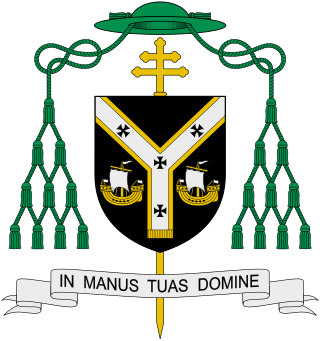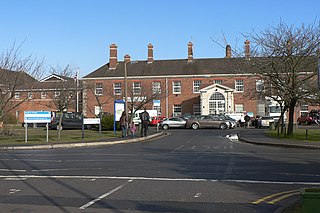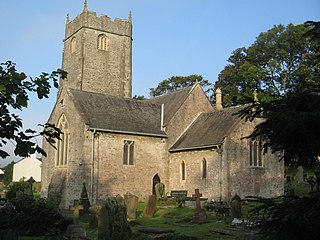
Presbyterianism is a part of the Reformed (Calvinist) tradition within Protestantism that broke from the Roman Catholic Church. Presbyterian churches derive their name from the presbyterian form of church government by representative assemblies of elders. Many Reformed churches are organised this way, but the word Presbyterian, when capitalized, is often applied to churches that trace their roots to the Church of Scotland or to English Dissenter groups that formed during the English Civil War.

The Vale of Glamorgan, often referred to as The Vale, is a county borough in the south-east of Wales. It borders Bridgend County Borough to the west, Cardiff to the east, Rhondda Cynon Taf to the north, and the Bristol Channel to the south. With an economy based largely on agriculture and chemicals, it is the southernmost unitary authority in Wales. Attractions include Barry Island Pleasure Park, the Barry Tourist Railway, Medieval wall paintings in St Cadoc's Church, Llancarfan, Porthkerry Park, St Donat's Castle, Cosmeston Lakes Country Park and Cosmeston Medieval Village. The largest town is Barry. Other towns include Penarth, Llantwit Major, and Cowbridge. There are many villages in the county borough.

South Wales is a loosely defined region of Wales bordered by England to the east and mid Wales to the north. Generally considered to include the historic counties of Glamorgan and Monmouthshire, south Wales extends westwards to include Carmarthenshire and Pembrokeshire. In the western extent, from Swansea westwards, local people would probably recognise that they lived in both south Wales and west Wales. The Brecon Beacons National Park covers about a third of south Wales, containing Pen y Fan, the highest British mountain south of Cadair Idris in Snowdonia.

The Evangelical Presbyterian Church in England and Wales (EPCEW) is a reformed and conservative evangelical Presbyterian denomination based in England and Wales with churches in Germany, Switzerland, and Sweden. Founded in 1996, the denomination is small but growing.

The Archdiocese of Cardiff is a Latin archdiocese of the Catholic Church which covers the south-east portion of Wales and the county of Herefordshire in England. The Metropolitan Province of Cardiff therefore covers all of Wales and part of England. Cardiff's suffragan dioceses are the Diocese of Menevia and the Diocese of Wrexham.

Llandough is a village, community and electoral ward in the Vale of Glamorgan, Wales, approximately 2.3 miles (3.7 km) south west of Cardiff city centre, and approximately 1.3 miles (2 km) north west of Penarth.
Frederick Thomas Pilkington (1832-1898), pupil of his father, was a "Rogue" British architect, practising in the Victorian High Gothic revival style. He designed mostly churches and institutional buildings in Scotland. Typical of his work is the Barclay Church in Edinburgh, a polychrome stone structure with early French Gothic details.

Architecture in Cardiff, the capital city of Wales, dates from Norman times to the present day. Its urban fabric is largely Victorian and later, reflecting Cardiff's rise to prosperity as a major coal port in the 19th century. No single building style is associated with Cardiff, but the city centre retains several 19th and early 20th century shopping arcades.

St Luke's Church is a United Reformed church in the Silverhill suburb of Hastings, a town and borough in East Sussex, England. The congregation was originally independent before taking up Presbyterianism, and worshipped in a private house from its founding in 1853 until a permanent church was provided in 1857; this was one of the oldest Presbyterian places of worship in southeast England. The growth of the community has resulted in several extensions since then, and severe damage caused by the Great Storm of 1987 was quickly repaired—except for the loss of the building's distinctive spire. The church, along with most other Presbyterian congregations, joined the United Reformed Church when that denomination was formed in 1972. It is one of four United Reformed Churches in the borough of Hastings.

Percy Thomas Partnership was the trading name of the award-winning British architectural practice established some time between 1965 and 1973 as the successor to a series of earlier partnerships originally set up by Percy Thomas (1883–1969) in Cardiff, Wales in 1911/12. Percy Thomas and the Percy Thomas Partnership put their name to a number of landmark buildings in the United Kingdom including the Wales Millennium Centre, Cardiff. It opened offices overseas and completed a number of prestigious buildings in Hong Kong.

The Welsh Presbyterian Church is a disused church on Princes Road in the Toxteth district of Liverpool, Merseyside, England. It is a redundant church of the Presbyterian Church of Wales, and is recorded in the National Heritage List for England as a designated Grade II listed building. Because of its tall steeple, the church has been nicknamed the "Welsh Cathedral", or "Toxteth Cathedral", although it was never an actual cathedral. In 2019, it received National Lottery Stage 1 funding to become a community hub after thirty years abandonment.

There are around 1,000 listed buildings in Cardiff, the capital city of Wales. A listed building is one considered to be of special architectural, historical or cultural significance, which is protected from being demolished, extended or altered, unless special permission is granted by the relevant planning authorities. The Welsh Government makes decisions on individual cases, taking advice from the heritage agency Cadw, the Royal Commission on the Ancient and Historical Monuments of Wales and local councils.

Habershon & Fawckner or Habershon, Pite & Fawckner was a British architectural practice active in England and Wales from the 1860s, particularly in Cardiff and the South Wales area. They had had offices in London, Cardiff and Newport, designing a large number of houses, villas and non-conformist chapels.

Saltaire United Reformed Church is a church at Saltaire, West Yorkshire, England. Commissioned and paid for by Titus Salt in the mid 19th century, the church is a Grade I listed building and sits within the Saltaire World Heritage Site.

The Church of St John the Baptist is a medieval church in Llanblethian in the Vale of Glamorgan, south Wales. Believed to have been built in the 12th century, the church boasts an unusual tower, consistent with the style more common in the south west of England. It underwent extensive restoration in the late 19th century, undertaken by C. B. Fowler of Cardiff. The Church of St John was listed as a Grade I building on 22 February 1963.
David Montgomery Vaughan (c.1810–c.1892) was a Welsh architect, surveyor, land agent and diarist.

Mount Stuart Square is a residential and commercial square in Cardiff, Wales. It is located in the Butetown area of the city. Originally developed in the late 1800s as a residential location for nearby dock workers, it quickly became a centre for upscale residential properties which revolved around the main square. By 1900, commercial activity had taken its place, dominated by the Coal Exchange, which occupied the once open central space. The square contains a high concentration of listed buildings, which represent a range of architectural styles and some of Cardiff's finest examples of late 19th and early 20th century commercial architecture. Mount Stuart Square area was designated a Conservation Area in July 1980.

St John the Evangelist Church is a heritage-listed Presbyterian church located at Main Street, Wallerawang, City of Lithgow, New South Wales, Australia. It was designed by Edmund Blacket and Blacket and Sons, and built from 1880 to 1881 by George Donald. It is also known as the Church of St. John the Evangelist. It was added to the New South Wales State Heritage Register on 10 September 2004.

The Weybridge United Reformed Church situate at Queen's Road, Weybridge, near to its junction with York Road, is a Victorian Grade II Listed church building that is now no longer used as a place of worship.

Winchester United Church is a joint United Reformed and Methodist church in the centre of the city of Winchester in the English county of Hampshire. Built between 1852 and 1853 to the Gothic Revival design of architects Poulton and Woodman for a congregation which had its origins nearly 200 years earlier, it is "incongruously set within the northern part of the former county jail", which had recently moved to a new site. Since 1974 the congregation has been a joint United Reformed and Methodist one, as the city's two Methodist chapels closed, the congregations merged and worship was concentrated on the one site. Historic England has designated the church a Grade II listed building for its architectural and historical importance.



















